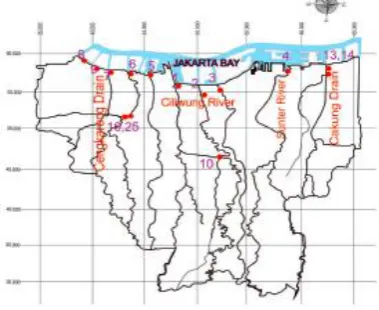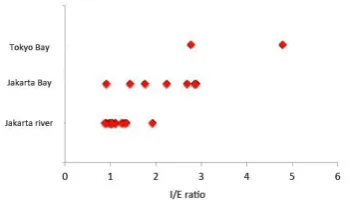Semirata 2013 FMIPA Unila |345
Molecular Marker of Sewage Contamination: Distribution of
Linear Alkyl Benzenes (LABs) in Jakarta River
Rinawati
1, Hideshige Takada
21
Universitas Lampung, Jl Sumatri Brojonegoro No 1 Bandar Lampung, 2Tokyo University of Agriculture and Technology, Fuchu shi, Tokyo, Japan
Abstrak. This study presents the result of sewage pollution monitoring in sediments collected from 13 rivers that run through Jakarta city in 2010 using linear alkyl benzenes (LABs) as molecular marker of sewage contamination. The surface sediments samples were extracted by pressure liquid extraction, purified by two-step silica gel column chromatography, and analyzed by gas chromatograph (GC)-mass spectrometer (MS). The result clearly revealed high total LABs concentrations (6171-1559373 ng/g-dry weight) in all sampling locations. I/E ratios (a ratio of internal to external isomers of LABs) ranged 0.9-1.3, were close to the I/E ratios in raw sewage. The high concentrations of LABs with low I/E ratios showed that the rivers in Jakarta are heavily affected by untreated sewage. This study highlights the urgently needed of water treatment system in Jakarta.
Kata Kunci : linear alkyl benzenes (LABs), molecular marker, sewage pollution
INTRODUCTION
Jakarta, now a metropolitan city, is characterised by a modern and lavish appearance, but the city is also overcrowded, with slum areas and limited sewage treatment systems. The increasing input of untreated sewage treatment to river and coastal environment due to rapid growing populations led to high health risk of people. Therefore, it is essential to measure the types and magnitude of wastewaters discharged into the aquatic environment.
To identify sources of sewage pollution, linear alkylbenzenes (LABs) have been proposed as a molecular marker. LABs with C10-C14 normal alkyl chains are the raw material used to produce linear alkylbenzene sulfonates (LASs). LABs are sulfonated during an industrial process to produce LAS, an anionic surfactant-containing detergent that is widely used for domestic cleaning. Small amounts (1-3%) of unreacted LABs are carried over to the detergent product, and these LABs are
released to the aquatic environment through the discharge of domestic waste. This small but significant amount of LABs can be detected in the environment.
environment. In synthetic detergent and untreated sewage, I/E ratios are around 0.5-0.9.
LABs were produced to replace tetrapropylene-based alkylbenzenes (TABs), which are feedstock for producing branched alkylbenzene sulfonates (ABS).
Due to the poor biodegradability and environmental problems, ABS was replaced by LAS detergent in the United States, western European countries and Japan roughly 60 years ago. Therefore, normally TABs were no longer detected in industrialized countries and were phased out by 1970. However, TABs were still detected in mussel and sediment collected from some Asian countries, including Indonesia. In this study, LABs concentration, I/E ratio, and TAB concentration will be used for sewage pollutant assessment in Jakarta.
METHODOLOGY
Surface sediment samples were collected
at 13 locations in Jakarta‘s rivers JKSE 1,
JKSE 2, JKSE 3, JKSE 4, JKSE 5, JKSE 6, JKSE 7, JKSE 8, JKSE 9, JKSE 10, JKSE 13, JKSE 14 and JKSE 25) from September
– October, 2010. Details of the sampling locations are available in Figure 1.
Figure 19 Sampling location in river sediment
One to two g of freeze-dried sediment was extracted by pressure fluid extraction in a Dionex ASE 200 accelerated solvent extractor using a 3:1 mixture of dichloromethane:acetone (v/v). The extract solutions were spiked with LAB surrogates. The LAB surrogate consists of 1-Cn LAB (n
= 8–14). Structures of LABs are expressed
as ‗‗m-Cn‘‘, where ‗‗m‘‘ refers to the phenyl substitution position on the alkyl
chain and ‗‗n‘‘ refers to the number of alkyl
carbons. The class of compounds including1-Cn LABs are not detected in commercial detergents or environmental samples, so these compounds were therefore used as the surrogates. The extracts were purified by two-step silica gel column chromatography and analysed by gas chromatography- mass spectrometer.
We quantified LAB congeners by comparing the integrated peak area of the selected ion (m/z = 91, 92, 105) with the peak area of the IISTD (biphenyl-d10, m/z =
164). Synthetic detergents and environmental samples contain 26 m-Cn
LAB congeners of non-terminal phenyl position (i.e., m ≥ 2 with a C10–C14 linear
alkyl chain (i.e., n = 10 – 14). The 26 congeners were measured, and the sum of
the 26 congeners was termed as ΣL Bs.
Fifteen peaks of tetrapropylene-based alkylbenzene (TAB) congeners with branched alkyl chains were identified and quantified as described previously [6]. The ratio of the sum of TABs to LABs is expressed as %TABs.
The alkylbenzene concentrations were recovery-corrected against the surrogate standards (deuterated PAHs and 1-Cn
Semirata 2013 FMIPA Unila |347
concentrations were <15%, and the recoveries were >83%. Procedural blanks for LABs were analysed with every batch, and analytical values five times the values of the blanks were considered significant.
RESULT AND DISCUSSION
The concentration of total LABs in sediment collected from rivers in Jakarta varied from 7,096 to 1,559,373 ng/g dry weight (dw) as shown in Figure 2. In general, the LAB concentrations in the east region of the sampling areas (JKSE 13 and JKSE 14, except JKSE 4) and the central region (JKSE 5, JKSE 1, JKSE 2, JKSE 3) were higher than the LAB concentrations in the sampling areas in the western region ( JKSE 8, JKSE 7, JKSE 6, except JKSE 9).
Extremely high concentrations were observed at sites JKSE 13 and JKSE 14, located downstream of the Cakung Drain, which runs through densely populated areas. These densely populated areas are also the preferred areas for many small industries that handle recycled products. Detergents are used extensively here in processes that contribute to the high LAB concentrations. These results coincide with LABs concentration at coastal location site, near at sites JKSE 13 and JKSE 14. Locations JKSE 5, JKSE 1, JKSE 2 and JKSE 3 are located in the Ciliwung River, which is the largest river flowing through Jakarta. Land use in the Ciliwung River Basin has changed drastically over the past 30 years from 1970 to 2005. The conversion from agriculture or green space areas into residential areas, industrial areas, and business sectors rose two-fold during this period. This conversion occurred in the upper and middle stream area and mostly in the downstream area, which corresponds to Jakarta City. The conversion brought a heavy burden and consequently loaded more pollutants into the river. The Ciliwung River also runs through 72 densely populated areas with many slum areas along the riverbank without adequate
treatment plants. Many of the city‘s drainage systems are linked to the Ciliwung River, so the river receives domestic, commercial, industrial, and agricultural wastes, among other types of waste. The high LAB concentrations observed in the Ciliwung River indicate a widespread input of waters with poor sewage water treatment. Locations JKSE 8, JKSE 7, and JKSE 6 are located in rivers that run through less populated, less commercial, and less industrial areas. The western region of Jakarta was principally proposed mainly as a residential area. However, location JKSE 9 had the highest LAB concentration among other locations in the western region and was comparable with locations in the central region. This location is downstream of the Kamal River and adjacent to the industrial area. This location possibly included a more densely populated area compared to other areas.
The total LAB concentrations in the present study were significantly higher than those reported in studies of other tropical countries. The rivers in Jakarta City apparently suffer from the intensive input of poorly treated sewage. The LABs in these rivers originate almost entirely from untreated domestic waste. Jakarta has only one sewage treatment area, located in Central Jakarta, so only limited areas are covered. Most parts of Jakarta do not have sewage treatment plants, and residents usually discharge their domestic waste directly into the rivers or coastal areas.
untreated sewage is a major contributor to the rivers in Jakarta A low I/E ratio was commonly observed in the urban rivers of other tropical Asian countries, such as Thailand, Malaysia, Philippines, Vietnam, Cambodia and India.
TABs are feedstock that produces branched chain alkylbenzene sulfonates (ABSs), which are surfactants that were used in the detergent industries in the past. ABSs have been replaced by LASs in many countries since the 1960s due to their poor biodegradability in the environment. In the present study, TABs were detected in all sampling locations at levels ranging from 1% to 12% (TABs/LABs, w/w). These values were lower than those from samples collected in 2000 (Figure 4), suggesting a decreasing trend of TAB usage as the raw material for the production of synthetic detergent. However, these results showed that TABs are most likely still used in synthetic detergent production in Jakarta. Isobe reported that high concentrations of TABs were also detected at several locations in canal/river sediment. These authors also confirmed that the commercial synthetic detergent available in Jakarta contained ABSs.
Figure 20 LABs concentration in river sediment
Figure 21 I/E ratio in sediment
Figure 22 TABs/LABs percentage in river sediment
CONCLUSION
LABs as molecular trace of sewage contamination have shown the sewage pollution in Jakarta. The high concentrations of LABs with low I/E ratios showed that the rivers in Jakarta are heavily affected by untreated sewage. The result also shows that TABs is still used in synthetic detergent production in Jakarta. This study highlights the necessity of the sewage treatment improvement in Jakarta.
ACKNOWLEDGEMENTS
This research was financially supported by the Environment Research and Technology Development Fund of the ministry of Education and Culture of Japan, and also Higher Education Directorate of Indonesia Government. Several undergraduates and graduates at our laboratory provided welcome assistance with the fieldwork.
REFERENCES
Semirata 2013 FMIPA Unila |349
Environmental Science & Technology. Vol. 34, p. 900-906.
Takada, H., Ishiwatari, R. (1987). Linear alkylbenzenes in urban riverine in Tokyo: Distribution, source, and behaviour. Environmental Science & Technology. Vol. 21, p. 875.
Takada, H., Ishiwatari, R. (1990). Biodegradation experiments of linear alkylbenzenes(LABs) : Isomeric composition of C12 LABs as an indicator of the degree of LAB degradation in the aquatic environment. Environmental Science & Technology. Vol. 24, p. 86-91.
Takada, H., Satoh, F., Bothner Michael, H., Tripp Bruce, W., Johnson Carl, G., Farrington John, W., 1997. Anthropogenic molecular markers: Tools to identify the sources and transport pathways of pollutants, Molecular Markers in Environmental Geochemistry. American Chemical Society. P. 178-195.
Macs-Zamora, J.V., Ramez-Alvarez, N. (2004). Tracing sewage pollution using linear alkylbenzenes (LABs) in surface sediments at the south end of the Southern California Bight. Environmental Pollution. Vol. 130, p. 229-238
Tsutsumi, S., Yamaguchi, Y., Nishida, I., Akiyama, K.-i., Zakaria, M.P., Takada, H., 2002. Alkylbenzenes in mussels from South and South East Asian coasts as a molecular tool to assess sewage impact. Marine Pollution Bulletin 45, 325-331.
Rinawati, Koike, T., Koike, H., Kurumisawa, R., Ito, M., Sakurai, S., Togo, A., Saha, M., Arifin, Z., Takada, H., 2012. Distribution, source identification, and historical trends of organic micropollutants in coastal sediment in Jakarta Bay, Indonesia. Journal of Hazardous Materials. Vo.l 217-218, p. 208-216.
Isobe, K.O., Zakaria, M.P., Chiem, N.H., Minh, L.Y., Prudente, M., Boonyatumanond, R., Saha, M., Sarkar, S., Takada, H. (2004). Distribution of linear alkylbenzenes (LABs) in riverine and coastal environments in South and Southeast Asia. Water Research. Vol. 38, p. 2449-2459.

